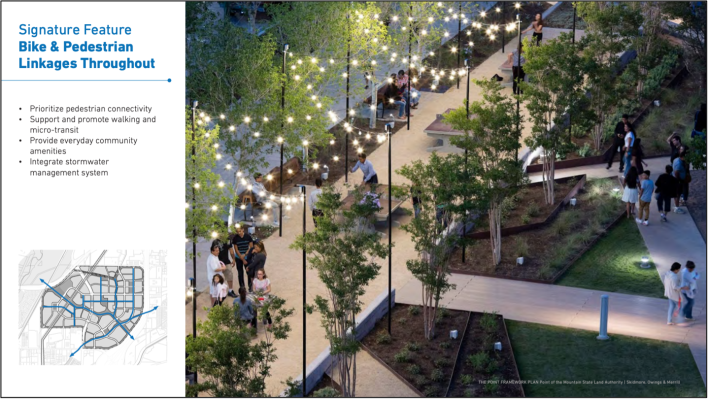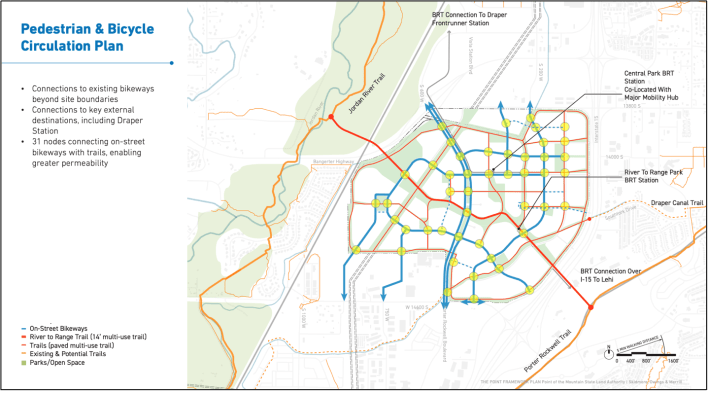A new planned community in Utah will strive to make it possible for residents to meet all their daily needs within 15 minutes without getting in a car — and to serve as a model for other U.S. developers who want to build basic mobility into the foundations of their designs.
Late last year, officials in Draper, Utah began a nationwide search for development partners to build the Point, a from-scratch neighborhood and "innovation hub" that will be constructed on roughly one square mile of state-owned land. But unlike many master-planned communities — a term that, at least in the U.S., has become heavily associated with tidy grids of suburban homes lining auto-centric roads — the Point will explicitly aim to "reduce the need for cars with extensive, regionally connected biking, walking, and transit systems."
The team behind the project is marketing the Point as a "one-car community," where each of the estimated 7,400 households within its footprint can realistically meet its needs with a single family car — cars which they hope residents will only use occasionally, since everyday destinations will be accessible by other modes.
Private developers have pursued similar concepts in the past, like the much blogged-about Culdesac development in Tempe, which will bundle a package of non-automotive mobility options into the price of rent when it opens later this year. But the Utah site may be the first publicly-sponsored project to pursue a car-light model, as well as the first U.S. community explicitly planned around the concept of the "15-minute city" from the ground up — a term coined by Franco-Colombian mobility expert Carlos Moreno to describe towns where residents can reach most of the destinations they rely on via a short walk, bike or transit trip from home.

The Point aims to achieve this utopia through a range of transportation strategies that will be familiar to sustainability advocates.
Vehicle traffic will be restricted from a .125-square-mile stretch of the downtown core known as a "pedestrian priority zone," while extensive active transportation network enables travelers to access every corner of the site without ever encountering a motor vehicle. (The handful of roads that do allow car traffic, of course, will all feature protected bikeways and sidewalks.)
Mixed-use zoning will put homes within easy reach of jobs, schools and essential services, and a dedicated city circulator — which the developers hope will be run by autonomous vehicle technology by the time the site opens — will ferry residents and visitors to destinations throughout the community, as well as to mobility hubs that provide access to car-share, bike- and scooter-share, and regional transit routes that run into adjacent cities. The leaders of the project are also exploring a "Mobility as a Service" app specific to the Point, which shows users the costs and travel times of various modes at a glance, making it obvious when driving isn't the best choice.
It's a veritable smorgasbord of next generation mobility trends that leaders say wouldn't be possible without the buy-in of state transportation leaders — and of Utahans themselves. The vision for the project was born directly out of an intensive public engagement process over the fate of the land beneath the Utah State Prison, which will close for demolition in May.
"Thousands of Utahans have expressed their vision for the future, and among those priorities was a future-focused transportation system that minimizes car dependence and impacts on air quality," said Alan Matheson, executive director of the Point of the Mountain State Land Authority, the government agency charged with overseeing the project. "Those public priorities really were put directly into this plan. I don’t know that this happens that often."

Utah residents' appetite for sustainable transportation certainly isn't anomalous among Americans, though some aspects of the Point project certainly are.
Nestled between two of the fastest-growing counties in the United States in a scenic mountain region that's become a hotbed for tech workers, the site represents a rare blank canvas of shovel-ready land in Utah's sought-after Silicon Slopes. Because it's already owned by the state, though, the developers the Authority ultimately selects to build the Point will have to answer to the public at large, rather than profit-minded investors alone.
Matheson says that Draper residents want the Point to not be just as green as possible, but also affordable to a range of income levels — and to inspire the car-dependent surrounding region to adopt those values, too. More than 76 percent of Draper residents commute to work in a single-occupancy vehicle, which is right on par with Americans at large, though he says the appetite for sustainable mobility options is growing fast.
"Because it’s a state project, we’ve got an obligation to residents throughout Utah, not just here," Matheson added. "Part of that obligation is creating a model community that can demonstrate good approaches and teach lessons that other developers can follow to address some of the challenges that we face in our state, like air quality, getting people active and improving public health, reducing infrastructure costs, and encouraging more of a sense of community. ... We have not just the responsibility, but the opportunity to try some things that a private developer, at least at this stage, would not."
Developers likely won't start building out that model community until late 2024, but Utah's vision for the Point could inspire other public leaders and private developers to consider building car-light communities of their own — or to retrofit the neighborhoods they've already got around the 15-minute city concept.
"One of the things I’ve learned over the years is that few developers want to be the first," Matheson said. "By designing this in a way that’s aspirational and also practical, and showing that it works, and that people want it, other developers can feel comfortable investing in similar ways."






